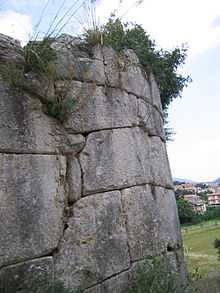Polygonal masonry
Polygonal masonry is a technique of stone construction of the ancient Mediterranean world. True polygonal masonry is a technique wherein the visible surfaces of the stones are dressed with straight sides or joints, giving the block the appearance of a polygon.[1]
This technique is found throughout the Mediterranean and sometimes corresponds to the less technical category of Cyclopean masonry.[2]
Italy
In Italy it is particularly indicative of the region of Latium, but it occurs also in Etruria, Lucania, Samnium, and Umbria; scholars including Giuseppe Lugli have carried out studies of the technique.[3][4] Some notable sites that have fortification walls built in this technique include Norba, Signia, Alatri, Boiano, Circeo, Cosa, Alba Fucens, Palestrina, and Terracina.[5]

The so-called Porta Rosa of the ancient city of Velia employs a variant of the technique known as Lesbian masonry.[1]

References
- ↑ 1.0 1.1 G.R.H. Wright (23 November 2009). Ancient Building Technology, Volume 3: Construction (2 Vols). BRILL. pp. 154–. ISBN 90-04-17745-0.
- ↑ Carmelo G. Malacrino (2010). Constructing the Ancient World: Architectural Techniques of the Greeks and Romans. Getty Publications. pp. 97–. ISBN 978-1-60606-016-2.
- ↑ Frank, T. 1924. “Roman buildings of the Republic: an attempt to date them from their materials.” MAAR 3.
- ↑ Giuseppe Lugli (1957). La Tecnica Edilizia Romana Con Particolare Riguardo a Roma E Lazio: Testo. 1. Johnson Reprint.
- ↑ Jeffrey Alan Becker (2007). The Building Blocks of Empire: Civic Architecture, Central Italy, and the Roman Middle Republic. ProQuest. pp. 109–. ISBN 978-0-549-55847-7.
- P. Gros. 1996. L'architecture romaine: du début du IIIe siècle av. J.-C. à la fin du Haut-Empire. 2 v. Paris: Picard.